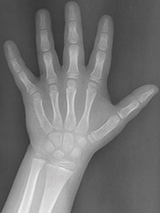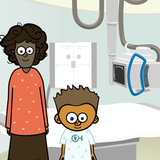X-Ray Imaging Tests
What is X-ray imaging?
X-ray imaging uses electromagnetic waves to create a fixed or still image of the inside of the body. Any part of your child’s body can be examined. Also called general radiography, X-ray imaging is the most basic form of medical imaging.
Several different terms, such as "film," "picture" and "X-ray" are used to describe the image produced.
The image is viewed and interpreted by a doctor, called a radiologist, to detect and diagnose medical conditions in the body.
After reading (interpreting) an image, the radiologist will send a report to your doctor. The radiologist may recommend further investigation through the use of other imaging methods.
What is an X-ray?

An actual X-ray is a form of energy. Depending on the energy level of an X-ray, it can either penetrate through the body, or is absorbed. The body and its tissues have many different densities, which will affect how an image appears. Areas such as bone are not easily penetrated. Therefore, they appear white on an image. Areas such as the lungs, which are mainly air, are penetrated very easily. Therefore, they appear black or grayish on an image. You cannot feel an X-ray as it goes through the body.
The X-ray machine consists of either a long table with a camera on top of it, or a large plate against the wall, with the camera pointing at it. The camera will not touch your child, but it may come close. There is a light, which will shine from the camera, to help the technologist position your child to get the best "picture" possible.

Help prepare your child for an X-ray procedure. This presentation explains what to expect before, during and after getting an X-ray in a simple, child-friendly way.
What should you do prior to your child's exam?
There are no specific preparations for general X-rays, but here are some general things to remember:
- Dress your child comfortably, in clothes that are easily removed. (Sweat clothes, t -shirts) Your child may be given a gown to change into for the X-ray, if required.
- Limit the use of jewelry and/or metal (zippers, snaps) in the area that is being examined.
Learn more about how to prepare for your child's radiology visit.
Note: Parents will be allowed to accompany their child into the exam room, other arrangements should be made for siblings.
Women who are pregnant or may be pregnant will be asked to leave the exam room during the procedure. Please make sure that there is someone else available to accompany the child during the exam, if needed.
What should you expect during the exam?

- The technologist will ask why the X-ray is being performed and will explain the procedure to both you and your child. Procedures vary depending on the part of the body being X-rayed. Most procedures require the technologist to take two to three images in different positions or from different angles.
- The technologist will ask your child to hold still and, sometimes, to hold his breath for a second. Your child will not feel the X-rays, but sometimes the required positions for the area being X-rayed are awkward or uncomfortable. These positions only have to be held for a couple of seconds.
- You may be asked to help with holding your child still during the exam. Any type of movement during an X-ray will show up blurry.
- The images appear on a computer screen and are sent to the radiologist to be read.
If you’d like, our child life specialists will help you prepare and support your child during the procedure. We can also arrange to have a child life specialist at your child's appointment to explain the procedure in developmentally appropriate ways and to help your child better cope with the stress of the hospital experience.
Our kid-friendly slideshow can help prepare your child for getting an X-ray.
What should you do after the exam?
There are no special instructions for your child to follow upon completion of this procedure
Test results
The images from your child's exam are interpreted on the same day and a report sent to your physician's office.
Your physician may call 215-590-2584 with questions about the exam.